|
G3VGR
|
MALERWEG Altendorf – Neumannmühle
|
 I had been anticipating this stage in the heart of the Elbe sandstone mountains for quite a few months and woke up pleased to notice clear blue skies and warm sunshine, so I would enjoy good views today.
Instead of the official route from Altendorf via Ostrauer Mühle, I decided to take the Personenaufzug and go via the village of Ostrau instead to get to the Schrammsteine.
The Personenaufzug is a metal contraption, built in 1904, and contains a modern lift that effectively links Ostrau and Bad Schandau.
From the platform at the top of the lift, there are fine views over Bad Schandau and along the Elbe.
Ostrau has some very nice large houses, resembling those in Switzerland and is on a plateau 50m above the surrounding area.
From the village were good views to the solitary Falkenstein and the Schrammsteine group.
The Schrammsteine is the largest collection of sandstone mountains in the Sächsiche Schweiz and stretches from Bad Schandau to Schmilka on the Czech Border.
This area is very popular with climbers, although I didn't see any on this day.
I had been anticipating this stage in the heart of the Elbe sandstone mountains for quite a few months and woke up pleased to notice clear blue skies and warm sunshine, so I would enjoy good views today.
Instead of the official route from Altendorf via Ostrauer Mühle, I decided to take the Personenaufzug and go via the village of Ostrau instead to get to the Schrammsteine.
The Personenaufzug is a metal contraption, built in 1904, and contains a modern lift that effectively links Ostrau and Bad Schandau.
From the platform at the top of the lift, there are fine views over Bad Schandau and along the Elbe.
Ostrau has some very nice large houses, resembling those in Switzerland and is on a plateau 50m above the surrounding area.
From the village were good views to the solitary Falkenstein and the Schrammsteine group.
The Schrammsteine is the largest collection of sandstone mountains in the Sächsiche Schweiz and stretches from Bad Schandau to Schmilka on the Czech Border.
This area is very popular with climbers, although I didn't see any on this day.
After leaving the village and walking into the forest, I connected with the Malerweg again and proceeded along the Bauweg until reaching the Grosses Schrammtor.
The Schrammtor is an area with narrow crevices between the high rock faces of the Schrammtoren and definitely suits its name as the gateway to the Schrammsteine.
The trail continued through the trees until I reached a signpost directing me to the Strammesteinaussicht.
The route to this viewpoint went steeply up a collection of steel ladders in the crevices of the towering rockfaces.
The ascent, being vertical in places was quite strenuous and I was pleased to stop at a small clearing about three-quarters of the way up.
I paused here to catch my breath whilst pretending to be studiously examining my Wanderführer.
After a few minutes, I scaled the last ladders to reach the summit.
From the outlook, the views in all directions were simply stunning. In front were the big rocks of the Schrammtor.
To the right was the Falkenstein and forest stretched to the horizon in all visible directions. There were about 10 other people at the summit, but it started to get busier after about 15 minutes, so I went down to the clearing.
From here there was a trail off to the left, but I went all the way back down to the bottom and continued along the trail.
After 20 metres, I was confronted by another collection of ladders, which I had to climb.
This ascent was almost as long as the previous one and when I reached the top, I noticed the trail from the clearing joining the trail here.
Unamused by this discovery, I carried on up another ladder until I was now on top of the Schrammsteine.
From this point, I started on a long ridge walk along the Schrammsteinweg, right across the top of the Schrammsteine, which was a great experience.
The vegetation here was mainly a combination of stunted pines and shrubs, interspersed by large sections of rock.
There were a few outlooks along the way from where I had outstanding views across the Elbe and upstream to the Czech republic.
When I eventually reached the end of the ridge, the trail doubled back around the rear of the Schrammsteine until I reached a clearing which had an excellent view.
To my left was the Schrammsteine, to my right the Affensteine and the solitary Falkenstein was straight ahead.
A very steep path provided with ladders and steps led downwards. The Sandlochweg trail through the forest from here was actually sand for quite a distance.
This didn't last and the Affensteinweg soon led to one of the typical nasty gravel roads through a forestry area.
I really dislike this type of road surface and remain convinced only the sharpest, pointiest stones are specially selected to make the appalling surface.
It may be OK for driving Land Rovers along, but the stones can be felt through even the thickest Vibram soles and makes walking unpleasant.
Fortunately, the tedium was interrupted by views of the high vertical rockfaces of the Affensteine.
Nearing Beuthenfall, I took a detour on another trail to the Kuhstall, which was eventually reached by slowly making my way up the last steep collection of steps of the day.
The big Kuhstall cave was a little disappointing as it has been converted into a tourist attraction and facilities built around it.
Despite my dislike of the additions to the Kuhstall area, I was grateful to take a beer at the cafe there.
As I made my way down towards the Kirnitztal, I met the 4 German hikers again.
The forest path ended at the Lichtenheimer Wasserfall. This was a real tourist trap, consisting of a feeble 5 meter high waterfall with just a small amount of water trickling down.
My arrival coincided with a coachload of Danish tourists. After one of them paid a sum to the cafe owner, the waterfall increased it's flow for almost 30 seconds, then reverted to it's previous trickle.
From this unsavoury experience, I was pleased I'd modified my route slightly to avoid any more "attractions". After a pleasant stroll along the riverbank to Beuthenfall, I waited for the
Kirnitzschtalbahn to arrive. This is the only tram in the world that runs through a national park, which it has done admirably since 1898.
It was a real joy to finish the day riding the antique tram as it rattled and clanked its' way down the valley to Bad Schandau
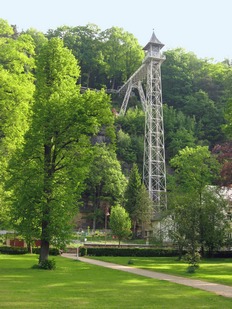
Personenaufzug
|
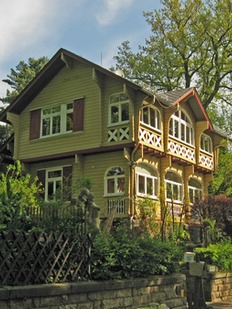
Typical house in Ostrau
|
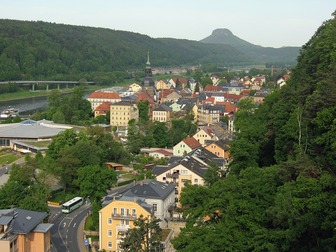
Bad Schandau from the Personenaufzug
|
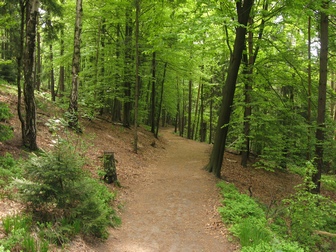
Along the Bauweg
|
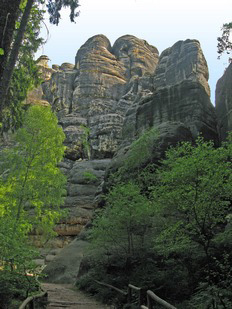
Approaching the Schrammtor
|

The long way up to the top
|
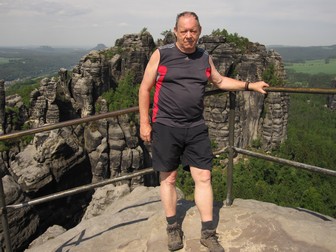
Made it Ma! - Top of the World!
|
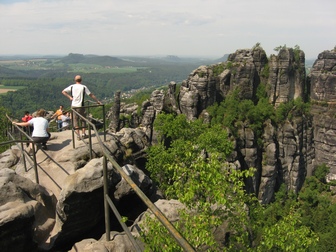
Schrammsteinaussicht
|
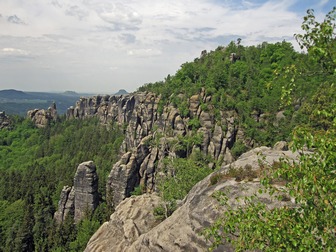
Another fine view
|

View upstream from end of ridge
|

First view of the Affensteine
|
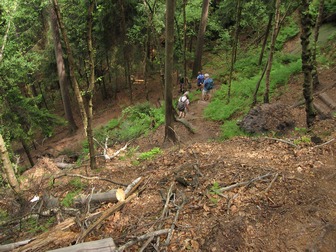
Steep descent from Schrammsteine
|
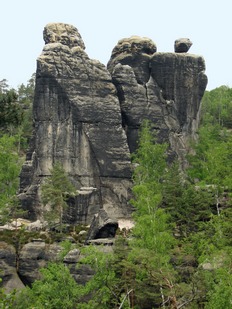
Affensteine
|

Along the Affensteinweg
|
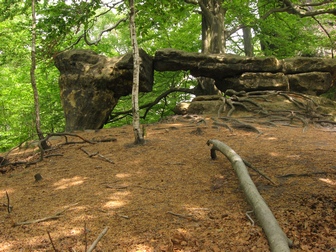
Along the Räumichtweg
|
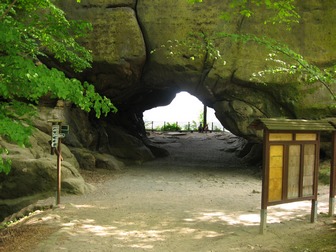
Kuhstall
|
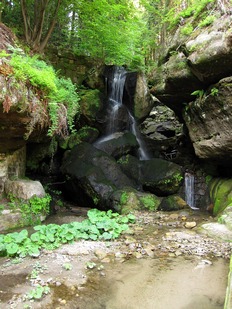
Lichtenheimer Wasserfall - unpaid view
|
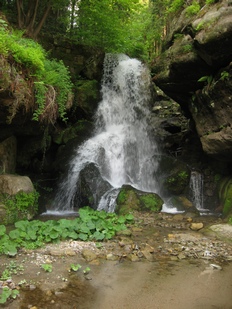
Lichtenheimer Wasserfall - paid view
|
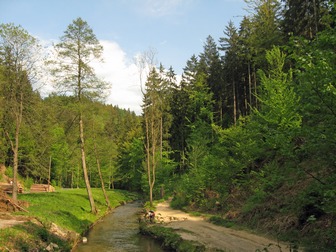
Along the Kirnitzsch river
|
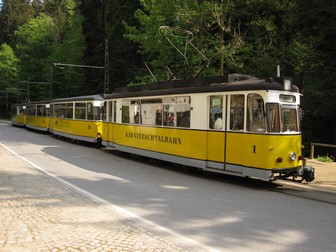
Kirnitzschtalbahn
|
 I had been anticipating this stage in the heart of the Elbe sandstone mountains for quite a few months and woke up pleased to notice clear blue skies and warm sunshine, so I would enjoy good views today.
Instead of the official route from Altendorf via Ostrauer Mühle, I decided to take the Personenaufzug and go via the village of Ostrau instead to get to the Schrammsteine.
The Personenaufzug is a metal contraption, built in 1904, and contains a modern lift that effectively links Ostrau and Bad Schandau.
From the platform at the top of the lift, there are fine views over Bad Schandau and along the Elbe.
Ostrau has some very nice large houses, resembling those in Switzerland and is on a plateau 50m above the surrounding area.
From the village were good views to the solitary Falkenstein and the Schrammsteine group.
The Schrammsteine is the largest collection of sandstone mountains in the Sächsiche Schweiz and stretches from Bad Schandau to Schmilka on the Czech Border.
This area is very popular with climbers, although I didn't see any on this day.
I had been anticipating this stage in the heart of the Elbe sandstone mountains for quite a few months and woke up pleased to notice clear blue skies and warm sunshine, so I would enjoy good views today.
Instead of the official route from Altendorf via Ostrauer Mühle, I decided to take the Personenaufzug and go via the village of Ostrau instead to get to the Schrammsteine.
The Personenaufzug is a metal contraption, built in 1904, and contains a modern lift that effectively links Ostrau and Bad Schandau.
From the platform at the top of the lift, there are fine views over Bad Schandau and along the Elbe.
Ostrau has some very nice large houses, resembling those in Switzerland and is on a plateau 50m above the surrounding area.
From the village were good views to the solitary Falkenstein and the Schrammsteine group.
The Schrammsteine is the largest collection of sandstone mountains in the Sächsiche Schweiz and stretches from Bad Schandau to Schmilka on the Czech Border.
This area is very popular with climbers, although I didn't see any on this day.







